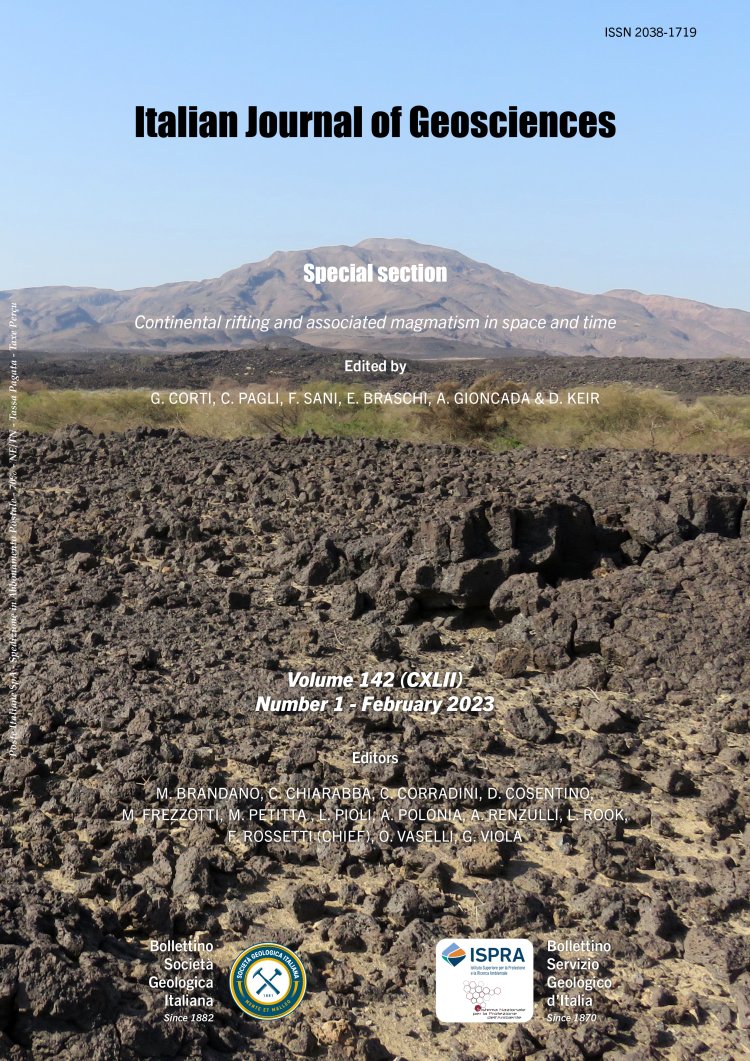
Time-space variations in the East African Rift magmatism: the role of different mantle domains
Alessandro Bragagni1,*, Eleonora Braschi2,*, Andrea Orlando2, Luisa Guarnieri1, Giacomo Corti2 & Simone Tommasini1
1Dipartimento di Scienze della Terra, Università degli Studi di Firenze, Via Giorgio La Pira, 4, 50121, Firenze, Italy.
2Consiglio Nazionale delle Ricerche – Istituto di Geoscienze e Georisorse, Sede Secondaria di Firenze, Via Giorgio La Pira, 4, 50121, Firenze, Italy. * *these authors contributed equally
Corresponding author e-mail: simone.tommasini@unifi.it
Volume: 142 (2023) f.1
Pages: 83-101
Abstract
The East African Rift System (EARS) is the classic example of an active continental rift where extensional tectonics and lithospheric thinning have been closely associated to the generation of large volumes of magmas and represents the environment with the largest range of erupted magma types all over the world. The geochemical signature of erupted magmas testifies the involvement of different mantle domains and depths (i.e., subcontinental lithosphere, asthenosphere and deeper mantle sources). Our aim is to investigate the variable contribution of different mantle domains in the genesis of the EARS magmas through space and time, considering not only the geochemical signature of erupted magmas but also the geochemical message of mantle xenoliths. The main goal is to provide a large-scale view of the common process driving the origin of magmas in the EARS beyond the local peculiarities linked to specific settings. To this aim, we screened an exhaustive geochemical database of basalts and mantle xenoliths from the EARS, and we report original trace element and Sr-Nd isotope data of new samples collected from the Main Ethiopian Rift and Turkana depression. The data were subdivided according to spatial and temporal criteria. From a spatial point of view, the samples were ascribed to five groups, namely: Afar, Ethiopia, Turkana, Eastern Branch, and Western Branch; from a temporal point of view, the magmatic activity of the EARS was subdivided into three main temporal intervals: 45-25 Ma, 25-10 Ma and 10-0 Ma. The geochemical and radiogenic isotope (Sr, Nd, Pb) signature of the selected basalts denotes the variable contributions of a mantle plume, a more depleted asthenospheric mantle (DMM), and different SubContinental Lithospheric Mantle (SCLM) domains, depending on their temporal and spatial distribution. The geochemistry of the selected basalts shows a marked correspondence with the compositional heterogeneity of mantle xenoliths, whose isotopic systematics (Sm-Nd, Re-Os) indicates the formation of the local SCLM in the Archean and during the Pan-African orogeny. Both SCLM domains contributed significantly to magma genesis in the Western Branch (whose signature points towards a contribution of the Pan-African lithosphere) and Eastern Branch (which is also affected by Archean SCLM domains) magmas. The contribution of the SCLM generally increases with time, possibly related to an increase of the geothermal gradient in response to the arrival and flattening of the plume head at the base of the lithosphere and later extension, thinning and shallower melting. Our interpretation supports a pivotal role of the different SCLM domains in magma genesis that is able to fully explain the large compositional heterogeneity of the EARS basalts and represents a reasonable alternative to the putative presence of multiple mantle plumes or a heterogeneous mantle upwelling.
Keywords
Get Full Text Supplementary Material